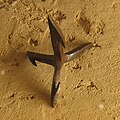Crow's foot
A crow's foot , also known as a throwing iron or ankle , is a defensive weapon, but not a guided weapon , which usually consists of four pointed iron pins that are tetrahedrally connected. Due to this arrangement, the crow's foot comes to rest on three of the tips, so that one of the tips always points straight up. The weapon probably got its name because of its resemblance to birds or crow's feet.
Mode of action
Crow's feet were used to injure enemy infantrymen on the feet and horses of the cavalry on the hooves in order to stop them in their advance and at least temporarily make them incapable of fighting. For this purpose, they were spread over a large area on the expected deployment area of the enemy before or during a battle. On most soils, such as grass, sand, fields and fields, crow's feet are difficult to see in the hustle and bustle of a battle. They usually have a diameter of 3 cm to 20 cm. Depending on the design, their tips are studded with barbs , which increase their injurious effect and make it difficult or even impossible to remove crow's feet in the field.
history

The earliest reference to the use of crow's feet came from Curtius Rufus at the Battle of Gaugamela on October 1, 331 BC. Crow's feet used in the ancient Roman Legion were barbed and were called tribulus ( plural tribuli ). This name is derived from the Latin synonym calcitrapa (foot trap), from which the English term Caltrop was derived. The Roman historian Flavius Vegetius Renatus described crow's feet and their use in detail in his work Epitoma rei militaris in the late 4th century.
Crow's feet could simply be spread by hand over an expected deployment field. Simpler tacks consisted of wire-shaped tips, some of which were reinforced with barbs and which were anchored in the ground on wooden sticks. Although these were of a simpler construction than the tetrahedral crow's feet, they had to be laboriously assembled on the battlefield and could not simply be spread over. Horses with injuries to the hooves and fallen horses meant that the riders had to dismount and continue fighting on foot. Especially armored horsemen ( Knight ) of the Middle Ages were severely limited in Fußkampf as their heavy armor , although optimized for a fight on horseback, however, were not designed for Fußkampf. Crows feet were also thrown at attackers by defenders in ceramic vessels filled with unslaked lime , the so-called storm pots . Crows feet are said to have played a strategically decisive role, among other things, in the Battle of Bannockburn in 1314 and in the Battle of Schönenbuchen between Black Forest farmers and the Duke of Armagnac 's troops . The latter was honored in 1771 by Joseph Zimmermann on a battle painting in the Schönau-Schönenbuchen chapel, where farmers scatter crows feet from baskets over the ducal troops.
In Japan there was a weapon with the same function, which was called Tetsubishi ( 鉄 菱 , German "iron rhombus"). Instead of metal tetsubishi, hard-dried beechnuts or water nuts were used, which easily penetrated through the usual straw sandals and also caused injuries.
In the First World War often crow's feet were in the trench warfare used and before the own trenches laid. After the Second World War , these were often used by smugglers against the customs investigation service.
At the moment, crow's feet are occasionally used by militant groups against the police in order to make their company vehicles unfit to drive, for example on the sidelines of counter-demonstrations around the G20 summit in Hamburg in 2017 and during a large-scale police operation in the Hambacher Forest in September 2018 In March 2019, the district of Traunstein threw offenders who were fleeing crow's feet from their car onto the street and were able to prevent police vehicles from pursuing them.
heraldry
The crow's foot is a common figure in heraldry and paraheraldry .
Ohníč municipality ( Czech Republic )
Bauschleiden commune ( Luxembourg )
Battalion badge of the III. Corps ( United States )
See also
literature
- Christof Flügel : Tribuli - Roman crow's feet . In: Bavarian history sheets . No. 75 , 2010, ISSN 0341-3918 , p. 143-146 .
Web links
- From wolf anchors, crow's feet, water nuts, wolf and foot anchors Working group minerals, fossils, gold, glass & fortification of the Friedrich-Ebert-Schule Schopfheim
- Wounded by crow's feet in the medieval manuscript war book from the 15th century, Zentralbibliothek, Zürich, Ms. Rh. Hist. 33b
Individual evidence
- ↑ a b c Christof Flügel : Tribuli - Roman crow's feet . In: Bavarian history sheets . No. 75 , 2010, ISSN 0341-3918 , p. 143-146 .
- ↑ Curtius Rufus: IV.13.36
- ↑ Flavius Vegetius Renatus : Epitoma rei militaris III24,3–4.
- ↑ Wounded by crow's feet in the medieval manuscript war book from the 15th century, Central Library, Zurich, Ms. Rh. Hist. 33b
- ↑ Fußangeln gegen Pferde 15th Century War Book , Central Library, Zurich, Ms. Rh. Hist. 33b, p. 115v
- ↑ Tweet from the Hamburg police. Retrieved July 6, 2017 .
- ↑ Hambacher Forst: Police take action against environmentalists and find strange "weapon constructions" derwesten.de, September 5, 2018
- ^ After the "crow's foot" attack on the police: Witnesses wanted pnp.de, March 7, 2019.







